Exploring Marshall School: A Journey into Holistic Education and Student Development
- tony65993
- Jul 1
- 16 min read
On May 1, 2025, the sunshine filtered through the gentle clouds, casting its rays over the lakeside, and the air was filled with the refreshing vitality of early summer. On this highly anticipated morning, we embarked on a journey to Marshall School, filled with excitement and curiosity, to explore its educational philosophy and student development.

Marshall School is a private boarding school located in Duluth, Minnesota, USA. From its campus, one can enjoy a view of the distant shoreline of Lake Superior. The environment is peaceful and beautiful, blending nature with humanistic charm. Marshall School adheres to the philosophy of "holistic education," not only focusing on students’ academic achievements but also striving to unlock each student’s potential. The school cares for their personal interests, character development, and future aspirations. Marshall offers a comprehensive curriculum, robust college guidance, diverse art and sports programs, as well as a unique outdoor leadership course. The school is dedicated to creating individualized growth pathways for each student, helping them discover the world through exploration and realize themselves through practice.

During this visit, we gained a thorough understanding of Marshall School’s campus environment, course offerings, teaching staff, student life, and future development opportunities. We had the chance to deeply appreciate how Marshall School, in an environment filled with humanistic care and educational mission, offers students a gateway to a broader world.


Our tour began with a warm reception by Admissions Director Derek. His detailed introduction gave us a deeper understanding of Marshall School's diverse and international educational philosophy.
The school currently has about 430 students, with a significant number of international students. The 21 boarders come from all over the world, including countries like Vietnam, South Korea, China, and the UK.
Marshall School’s dormitories remain open year-round, which is one of its unique advantages, something that many other schools cannot provide. Whether it’s winter, spring, or Christmas break, students can stay on campus where food, accommodation, and various activities are provided. This is especially important for international students far from home, as the school's care and companionship during the holidays greatly ease their homesickness.
These students from various cultural backgrounds not only add diversity to the classrooms but also enrich extracurricular activities. To enhance students’ extracurricular experiences, Marshall School arranges activities based on students’ interests, such as trips to the largest shopping mall in the U.S., Mall of America, or to the Great Wolf Lodge indoor water park. These activities allow students to enjoy their free time after a busy academic schedule.
Derek also mentioned that the school is in an excellent location, with two large hospitals nearby, providing convenient healthcare services for students. This thoughtful arrangement reassures parents, ensuring that students’ health is well cared for.
The entire tour was relaxed and warm, and Derek’s introductions gave us a comprehensive understanding of Marshall School’s academic, lifestyle arrangements, and student care. The school’s international vision, inclusivity, and holistic care for students left a deep impression on us.
Next, we began our campus tour, starting with a visit to the school’s dining hall. Derek introduced us to the fact that although upper school students are not required to eat in the dining hall, elementary and middle school students must dine there. In the buffet line, students can choose from hot dishes, salads, and a variety of fruits and vegetables. Today’s menu included hamburgers, with different dishes offered on other days to ensure food freshness and variety.
The dining hall is spacious, with tables and chairs neatly arranged. This is the primary dining area for lower and middle school students, while high school students have the option to dine elsewhere. The dining hall also offers healthy food options, and special accommodations are made for students with food allergies or intolerances to ensure they can safely select appropriate meals.


We then visited the school’s athletic facilities. Marshall School’s main gym serves as a venue for basketball and volleyball training and is also a multifunctional space suitable for various sports. After school, students can use the gym for physical exercise and activities until 9 p.m. To ensure safety, there are staff members managing the gym.

On the second floor of the gym, we saw more facilities, including indoor spaces for outdoor sports. The school offers a variety of sports, including baseball, lacrosse, soccer, and softball. These activities are often held indoors during bad weather, especially in spring when outdoor fields may become slippery due to melting snow. This indoor space is particularly convenient for students to train anytime, whether it’s the cold winter or wet spring.

Derek also pointed out that the school’s athletic facilities have recently been renovated as a result of annual parent donations through the "Fund and Needs Campaign." These improvements provide students with more advanced sports equipment and better training environments. All boarders have free access to these facilities after school and on weekends, whether for personal exercise or casual sports with friends. Even without professional coaches on-site, students can use these facilities with their peers.

The school also provides each student with freedom and autonomy in their exercise. Students can create their own workout schedules based on personal needs and interests. If students are uncertain about which activities to do, the school’s coaches and sports teachers offer guidance to ensure students receive the proper support.
After visiting the athletic facilities, we moved on to the school’s art classrooms. Marshall School’s art courses span various fields, from traditional painting and sculpture to modern digital art and ceramics. The school provides a flexible environment for students to freely express their creativity, select art directions based on personal interests, and even prepare portfolios for future art school applications. Many students also choose to take AP Art courses to further improve their artistic skills.

It’s worth mentioning that the school has a National Art Honor Society, which holds activities every two weeks, offering students more opportunities for artistic creation and hosting art exhibitions and creative events.

Derek also pointed out that the school regularly organizes all-school art exhibitions, showcasing the students’ artwork. On May 21, the school will hold an art exhibition, featuring works from students ranging from kindergarten through 12th grade. The entire community is invited to participate and experience the students’ artistic talents.
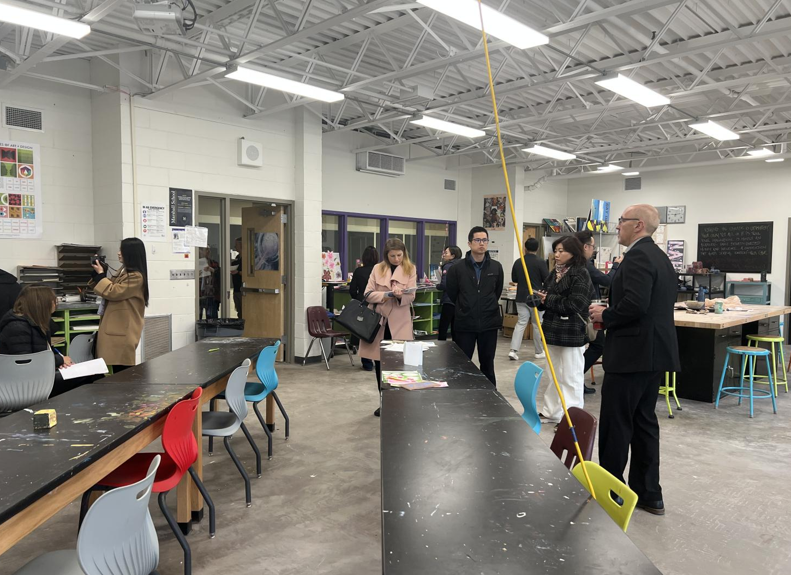
In addition to traditional art courses, the school offers unique activities like a course where students learn canoe-building skills over eight days and create their own canoe and paddles. These special courses offer students a fun and challenging way to learn and experience something different.
Baking is also a popular activity at the school. Derek mentioned that the baking courses are always filled with creativity and joy. Students often share the desserts they make with their peers after class. These courses not only teach students how to make delicious treats but also foster teamwork and creativity.
In general, Marshall School’s art programs are rich and diverse, offering everything from traditional arts to innovative handcrafts, giving students the opportunity to explore and develop their artistic talents.

Next, we visited the school’s health center. The health center is equipped with a professional team of nurses to ensure the students’ health is well taken care of while at school. Nurses work here every weekday to provide daily health care, first aid, and regular health checks. Whether it's minor illnesses or long-term health issues, students can get timely help and care here.
The health center is warm and well-equipped. In addition to basic medical equipment, there are comfortable resting areas for students to use if they’re feeling unwell. With the help of the school doctor, students can easily access the necessary medical services, and even in emergencies, they can receive quick treatment or be referred to local medical institutions.
Moreover, the health center provides multi-language support for international students, ensuring they fully understand their health issues and the treatments required.
This comprehensive health management system creates a safer and more comfortable learning environment for students, reassuring parents as they send their children here.
We then visited the classrooms for grades K-4. The classroom environment is very friendly and creative, with teachers encouraging students to think and practice actively through interactive and project-based learning. The classrooms are decorated with colorful, interesting materials and tools to foster creativity and teamwork.

Afterward, we visited the humanities classrooms for middle school students. These courses include English, history, and geography, and through interdisciplinary projects, they help students build a broader knowledge system. In class, students not only learn basic knowledge but also cultivate critical thinking and problem-solving skills through group discussions and collaborative projects. Teachers encourage students to ask questions, challenge traditional ideas, and look at the world from different perspectives. This approach not only sparks students’ curiosity but also develops their communication and teamwork skills, laying a solid foundation for future academic challenges in high school.
Next, we learned about the school’s internship programs. Through partnerships with local businesses and organizations, the school offers students various internship opportunities. These programs not only help students apply theoretical knowledge from the classroom but also expose them to different industries, allowing them to explore potential career interests.

We also visited the engineering lab. Here, students have the opportunity to use advanced tools and equipment to conduct experiments and design projects. These facilities not only provide a platform for practical experience but also spark students’ creativity and engineering thinking. Whether it’s mechanical design or electronic circuits, students can practice hands-on in this lab, deepening their understanding of basic engineering concepts and developing their problem-solving skills. At the same time, we also learned about the school’s robotics program.

The robotics club is a popular winter activity, and every year, students participate in the First Robotics competition. This program involves designing and building robots, as well as programming and teamwork. Students learn how to solve complex problems within a limited time and how to leverage their strengths in a team. The school’s robotics club typically has about 10 members, offering a variety of activities in areas like design, programming, and marketing, ensuring every student finds their role and interest in the project.

Of course, the school’s class sizes are relatively small, with about 15 students per class in middle school, which allows for a more personalized learning experience. The elementary school class sizes range from 10 to 20 students, and the smallest class size is only 8 to 10 students. This ensures that students receive more attention and guidance from teachers, and it also provides more opportunities for interaction and discussion. This classroom setup creates a relaxed and supportive environment where students can grow in academic, social, and personal aspects.
Next, we passed by the international student display area, where there is a board showcasing the names of international students from around the world. The school’s international program started in 2006 with a homestay program designed to help international students integrate into local culture. As the school grew, the homestay program gradually evolved into a formal boarding program, providing more stable and comprehensive support for students from all over the world. This transition allows the school to better serve international students, helping them adapt to a new learning and living environment while promoting cultural exchange and enhancing students’ global perspectives.

The school is committed to creating an inclusive environment, encouraging students from different cultural backgrounds to interact and integrate here, allowing everyone to feel the school’s respect and welcome for global cultures.
We then visited the school’s library, an important part of the academic life at Marshall School. Students not only borrow books here, but they can also use this space after school and during free periods for study and reading. The library is uniquely decorated, with flags from different countries displayed on the walls, representing the diversity of the school's international students. These flags make every student feel recognized for their culture and demonstrate the school’s respect for globalization and multiculturalism.
The next session was a meeting with the school’s faculty. The first teacher we met was Katie, the college counselor, who has worked at the school for 21 years. She is responsible for providing comprehensive guidance on college applications and helping students plan their future academic paths.

In 9th grade, college counseling focuses on helping students understand how to get involved in academic activities and emphasizes the importance of grades, helping students establish good study habits.
In 10th grade, counseling becomes more in-depth, with students starting to intentionally select extracurricular activities and academic projects that will lay the foundation for future college applications.
11th grade is the most intensive period in the college application process. At this stage, Katie meets with students one to two times a week to help them understand the college application process, including filling out the Common App (the U.S. common college application) and providing feedback on their application essays. Additionally, Katie helps students prepare recommendation letters to ensure their application materials highlight their personal strengths.
In 12th grade, students enter the final application stage. Katie provides more personalized guidance to ensure they stand out in their applications.
The school’s college counseling services also offer a special program called the Minnesota College Counseling Group, which specifically assists international students. This group helps them understand the universities in Minnesota and provides advice and support for their applications, ensuring that international students can transition smoothly into American university life. Next year, 37 students will apply to colleges, reflecting the school’s expertise and long-standing experience in college counseling.

We then met with Kevin, the head of the sports department, who has been with the school for 13 years. He emphasized the importance of physical activity in education. Minnesota requires students from 7th to 12th grade to actively participate in sports, which is why the school places great importance on sports programs, offering a variety of choices.

The school’s dance program is part of the sports department and aims to help students improve physical fitness while cultivating artistic expression through dance.
Winter sports are the school’s strongest athletic programs. The boys' and girls' soccer teams have performed exceptionally well on a national level, achieving outstanding results. Ice hockey is also one of the school’s strong suits, with the team regularly earning excellent results in competitions. Basketball is another highly competitive sport, with the school’s basketball team frequently excelling in regional tournaments.
Additionally, the girls’ swimming program collaborates with local public schools, which allows students to benefit from more training resources and opportunities. The school’s golf program is unique in that although it doesn’t have its own golf course, there is one located about a 10-minute drive away, where students can train and compete.
In general, the school’s sports programs offer a wide range of options for students, focusing not only on athletic achievement but also on developing teamwork and physical fitness.
Finally, we met with Megan, the high school academic director, who joined the school in February of this year. She previously worked at Westtown School, which provided her with a solid foundation for her role here.

Megan introduced the school’s outdoor leadership and pathways programs, which emphasize practical experience, especially in outdoor leadership. Through these programs, students not only develop leadership skills but also engage in teamwork and problem-solving activities in natural environments, which enhances self-management and creative thinking. The course combines classroom learning with hands-on activities, aiming to cultivate students' comprehensive abilities and prepare them for future challenges.
After the meeting, we continued with classroom visits. We first visited the British literature class, where students were divided into groups to collaborate on a topic and then present their findings at the end of the class. Teachers typically assign reading materials as homework, ensuring that students come to class well-prepared. This approach not only encourages students to take initiative in their learning but also helps them develop teamwork skills and public speaking abilities. The interactive classroom atmosphere allowed students to deepen their understanding of the literature and sharpen their critical thinking skills.

Next, we visited the biology class. The school sends electronic updates to all student families every week, detailing the latest news from the school. For international students, the school also provides monthly updates, highlighting key information about boarding life and arrangements. The boarding director maintains regular contact with each student’s family to keep them informed of their child’s daily performance and progress and addresses any concerns or questions.
The class size for biology typically ranges from 15 to 20 students, which helps the teacher give each student more attention and ensure that everyone receives adequate guidance and support in class.


We then visited the chemistry class. The chemistry classroom is connected to the chemistry lab via a hallway, which makes it very convenient for students to transition between theoretical learning and practical experiments. The teacher always supervises the lab to ensure safety, oversee the experiment process, and handle any potential safety hazards. The school emphasizes hands-on learning and encourages students to deepen their understanding of chemical principles through experiments, developing their lab skills in the process.
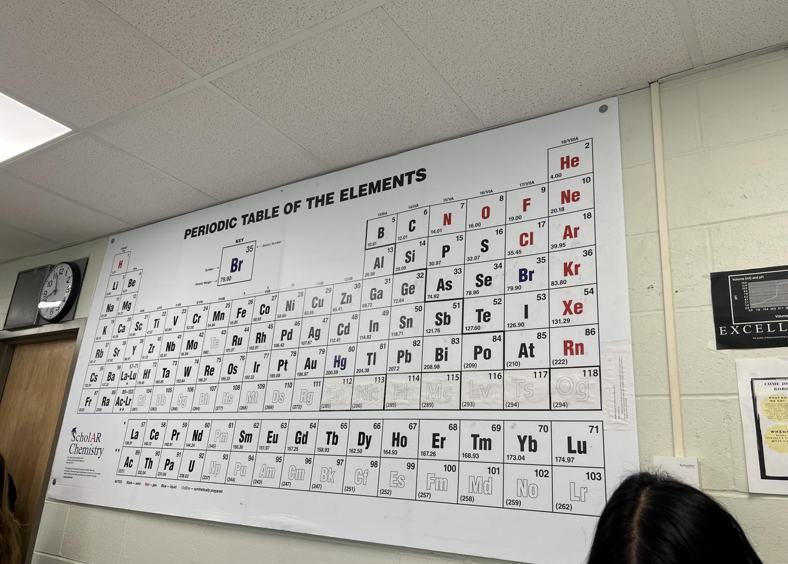

Next, we visited the art classroom, which is full of creativity. Every year on May 21, the school holds a grand art exhibition showcasing the students' creative works from the year. Whether it’s painting, sculpture, or other forms of art, students are given the opportunity to express their creativity and ideas. The school provides a flexible and supportive environment, encouraging students to explore their artistic interests and display their work through exhibitions.

We then visited the school’s theater, a key venue for cultural events. Graduation ceremonies, all-school ensemble performances, and other major events are held here. Every year, the school organizes three major performances – the fall musical, winter play, and spring celebration performance. Each performance serves as an important opportunity for students to showcase their talents and experience the collaborative nature of artistic creation. Additionally, the school regularly hosts three concerts, featuring choral and orchestral performances, greatly enriching the students' extracurricular arts activities.


We also visited the choir room, where students rehearse for musical performances. The school’s choir and orchestra programs are strong, with many students winning awards in music competitions. Participation in the arts is required for every student, whether it's choir, band, theater, or dance. These programs not only help students enhance their artistic literacy but also foster teamwork and creativity.


Finally, we visited the school’s band and symphony orchestra. These programs are highly competitive, and students not only have opportunities to showcase their talents within the school but also participate in external competitions and performances. In the fall semester, the school organizes two theater performances, which are created and rehearsed by the students themselves, showcasing their talents and hard work. The school’s music program has also achieved remarkable success, with many students receiving various awards for their outstanding performances. The entire campus is filled with the spirit of art, and students not only acquire knowledge but also develop emotional expression and creative thinking through the arts.

Next, we went to lunch and entered the student dormitory dining hall, where we were welcomed by the school’s leadership. The headmaster greeted everyone during lunch, offering support and encouragement to both students and faculty, making everyone feel the warmth of the school community.
During our conversation, we also met Dylan, the ESL and Spanish teacher, who introduced us to the school’s language programs. Dylan mentioned that the school offers special English language support courses for non-native English speakers to help them improve their language skills and adapt to the English-language teaching environment. Additionally, the school offers Spanish courses to help students understand Western culture and learn another foreign language, preparing them for future multicultural exchange.
The entire lunch time was filled with warm communication and interaction, and the leadership, teachers, and students showed enthusiasm and friendliness, giving us a deeper understanding of Marshall School’s culture and support.

After lunch, we met with Bettina, the boarding director, who introduced the school’s boarding arrangements. Most students live in single dormitory rooms, each equipped with essential amenities to ensure a quiet and comfortable environment for studying and living. Besides the daily dorm life, the school hosts a “Sunday Gathering Dinner” every week, where students cook together and share their cultures and cooking experiences, fostering mutual understanding and friendships.


We then visited the various facilities in the dormitory area. First, we visited the Boys’ Shower Suite and Girls’ Shower Suite. These facilities are designed to ensure students have a clean and comfortable environment. Each shower room is thoughtfully designed with privacy in mind, and the rooms are equipped with ample storage and toiletries, ensuring students can rest and freshen up after their busy study and extracurricular activities. We also noticed that each student dormitory room has a private sink, offering students a convenient personal hygiene facility for easy washing and organizing.


Next, we visited the Common Area in the dormitory. This is a spacious area where students can socialize and relax. It provides a place for students to discuss, play games, watch movies, or just chat with friends. This area is essential for student interaction, and the school regularly organizes group activities here to foster friendships among students.

We also visited the Study Hall. Every evening from 8 to 9 p.m., the school offers study time for students who need it. This hour is not mandatory, but for students who need additional academic support, the school requires the students to focus on their studies and complete their assignments during this time. This approach encourages students to develop good study habits and provides extra support to help improve their academic performance.

Additionally, we saw the dormitory's Hang Out Space. This area serves as a place for students to relax and socialize, especially during weekends or holidays. Students can invite day students to the dormitory for small gatherings or parties, enjoying a laid-back social time. This space also fosters interaction between boarding students and day students, helping them form closer relationships and friendships.

Through these visits, we gained a deeper understanding of the accommodation facilities and academic support at Marshall School. These facilities not only provide convenient living conditions for students but also promote their social, academic, and physical development through well-designed public spaces and learning environments.
Today's visit gave us a deeper understanding of Marshall School and allowed us to clearly see the unique advantages the school offers in areas such as academics, arts, sports, and leadership development. Marshall School is not only focused on students' academic achievements but also provides numerous opportunities for each student to develop a well-rounded personality, helping them prepare for future challenges.

In terms of academics, the school’s STEM (Science, Technology, Engineering, and Mathematics) program stands out. Through this program, students not only gain in-depth knowledge in the core subjects but also cultivate innovation and problem-solving abilities through hands-on practice. Activities such as the engineering lab and robotics club provide students with opportunities to experience the limitless possibilities that technology offers, sparking their creativity and hands-on skills.
Meanwhile, the school’s drama courses and related performance activities provide students with a stage to showcase their self-expression and creativity. Every year, the school holds several performances, enriching the students' artistic experiences while building their confidence and teamwork skills. Notably, the school’s three major concerts and theater performances are highlights of the school culture, showcasing Marshall School’s profound foundation in arts education.
The school also places great emphasis on outdoor leadership and teamwork development. Through outdoor leadership programs, students can hone their leadership abilities, improve practical problem-solving skills, and enhance cooperation through team activities. These experiences not only contribute to students' personal growth but also lay a solid foundation for their future career development and social adaptability.

In sports, Marshall School’s basketball program is one of the school’s major highlights. Both the boys' and girls' teams have achieved significant success on a national level. In addition, the school excels in ice hockey, soccer, and swimming, providing students with abundant sports and competitive opportunities. Regardless of whether students have prior experience in these sports, the school offers support and training to help them improve their skills and cultivate sportsmanship.
The school’s geographical location also provides students with a beautiful and tranquil learning environment. Located in a picturesque small town with serene natural surroundings, students can find a balance between study and life, enjoy peaceful campus life, and experience the beauty of nature at any time.
Furthermore, Marshall School has established close partnerships with local universities, which is especially attractive to international students. After studying here for over two years, students can apply directly to local universities without language requirements and are eligible for scholarships of up to 40%. This provides students with more opportunities for further education and helps them transition smoothly into higher academic environments, further expanding their academic and career paths.

Overall, Marshall School offers students a comprehensive, challenging, and supportive educational environment. The school not only emphasizes academic performance but also encourages students to excel in the arts, sports, and leadership development. Through a diverse curriculum, a wide range of extracurricular activities, and personalized guidance, the school ensures that each student can find their own development path and lays a solid foundation for their future educational and career pursuits. Today’s visit has made us even more excited, as we believe that Marshall School will continue to nurture talented, socially responsible young people, preparing them to become future leaders and innovators in society.












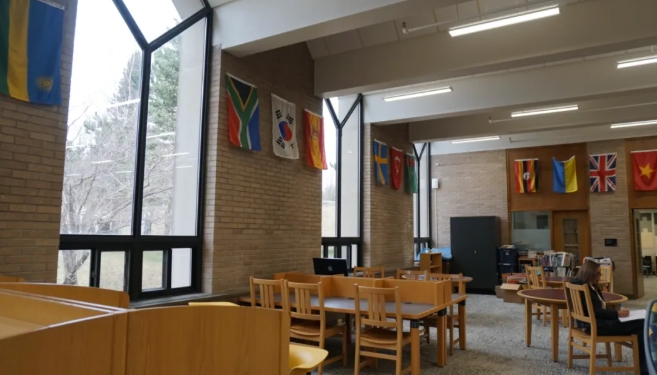

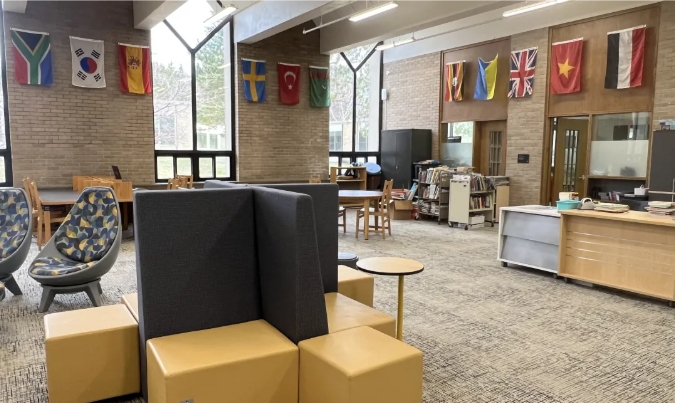



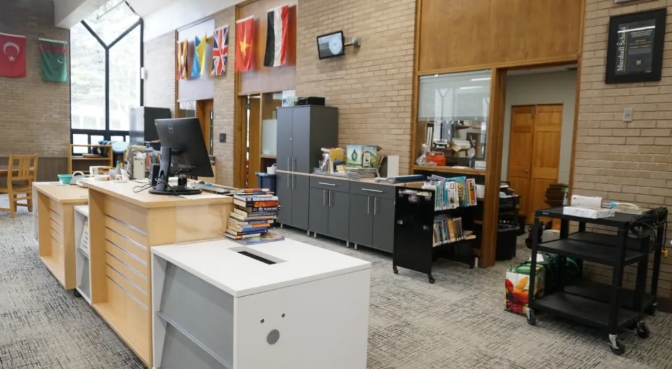

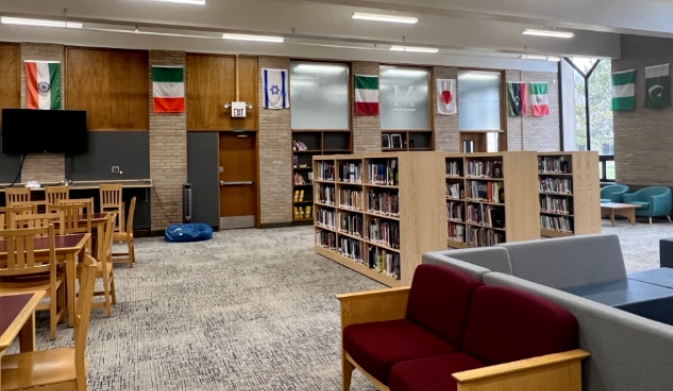











Beth Dutton’s timeless fashion sense shines through in the Beth Dutton Style. For fans who want a complete wardrobe, the Beth Dutton Clothing Store offers jackets, dresses, and shirts with authentic Yellowstone vibes. Explore her iconic looks now at the official Rip Wheeler Outfit store.